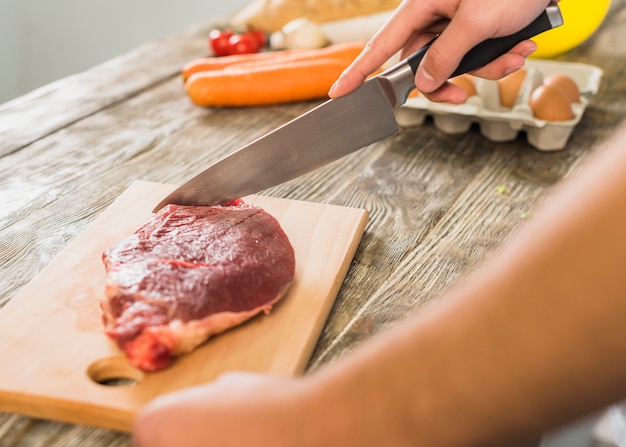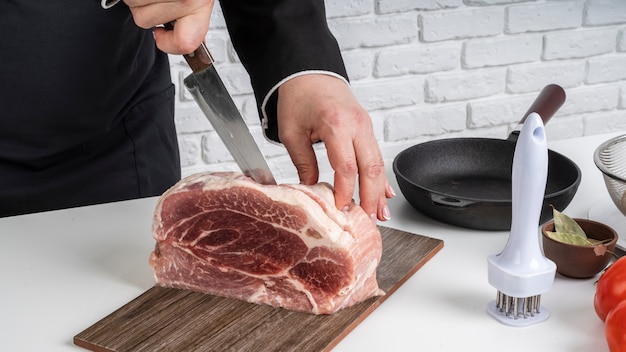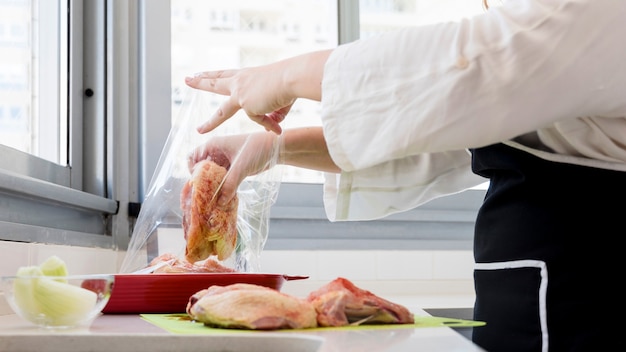(Part 1) The Importance of Internal Temperature: Unveiling the Science of a perfect pork tenderloin

Before we get into specific temperatures, let's understand why internal temperature is so crucial for pork tenderloin. It's not just about safety – although that's important – but also about achieving that perfect balance of doneness and tenderness. Think of it this way: pork tenderloin is a lean cut, meaning it's naturally low in fat. This makes it prone to drying out if cooked for too long. As the temperature rises, the muscle fibers contract, releasing their moisture. If you push the temperature too high, you'll end up with dry, tough meat.
The Magic Number: 145°F for a Safe and Delicious Pork Tenderloin
The United States Department of Agriculture (USDA) recommends cooking pork tenderloin to an internal temperature of 145°F (63°C). This ensures that any harmful bacteria are destroyed while maintaining a juicy and delicious final product.
Don't Be Afraid to Aim for Medium-Rare: Exploring the Spectrum of Doneness
Now, you might be thinking, "145°F? Isn't that a bit well-done?" Well, not necessarily. Remember, 145°F is the minimum safe temperature. You can cook your pork tenderloin to a slightly lower temperature for a more tender and juicy result. Medium-rare pork tenderloin, which typically sits around 140°F (60°C), is often considered the most flavorful.
But, before you dive headfirst into medium-rare territory, it's important to understand your own comfort level. If you're hesitant about eating pork that's not fully cooked through, then sticking to the USDA recommendation of 145°F is perfectly fine. The key is to understand your options and make an informed decision based on your preferences.
(Part 2) Measuring Internal Temperature: Your Essential Tools for Pork Tenderloin Success

Now, how do you actually measure that crucial internal temperature? Here are the tools that will become your best friends in the kitchen:
1. meat thermometer: The Gold Standard for Accurate Readings
A meat thermometer is a must-have for anyone serious about cooking. It's simple to use and provides accurate temperature readings, ensuring you're cooking your pork tenderloin to the exact temperature you want.
2. Instant-Read Thermometer: A Quick and Easy Option for the Busy Cook
If you're short on time, an instant-read thermometer is a lifesaver. It gives you quick, precise readings within seconds, allowing you to check the temperature of your pork tenderloin without waiting around.
3. Oven Thermometer: Essential for Maintaining Consistent Oven Temperatures
A consistent oven temperature is crucial for even cooking, especially when it comes to a delicate cut of meat like pork tenderloin. An oven thermometer helps ensure that your oven is actually at the temperature you've set it to, giving you more control over the cooking process.
(Part 3) Cooking Methods and Internal Temperature Targets: Choosing the Best Approach for Your Pork Tenderloin

Now that we've covered the tools, let's explore different cooking methods and the specific temperatures you should aim for:
1. oven roasting: A Classic Method for Evenly Cooked Pork Tenderloin
Roasting in the oven is a time-tested technique that allows the tenderloin to cook evenly and develop a beautiful golden-brown crust. For a medium-rare pork tenderloin, aim for an internal temperature of 140°F (60°C). If you prefer a more well-done result, cook it to 145°F (63°C).
Additional Tips:
- Seasoning is key! Generously season the tenderloin with salt, pepper, and any other herbs or spices you love. Get creative and explore different flavour profiles.
- Use a roasting rack. Place the tenderloin on a roasting rack in a baking dish to allow air circulation and ensure even cooking.
- Cook at a moderate temperature: Aim for 375°F (190°C) for optimal results.
2. Pan-Searing: Achieve a Crispy Crust for an Extra Touch of Delight
Pan-searing is perfect if you want a beautifully browned crust. The quick, high-heat cooking method seals in juices and develops a delicious flavor. For pan-seared pork tenderloin, aim for an internal temperature of 140°F (60°C) for medium-rare or 145°F (63°C) for well-done.
Additional Tips:
- Pat the tenderloin dry: Before searing, pat the tenderloin dry with paper towels to help achieve that crispy crust.
- Use high heat: Heat your pan over medium-high heat before adding the tenderloin. This ensures a nice sear.
- Don't overcrowd the pan: If you have a large tenderloin, cook it in batches to ensure even searing on all sides.
3. Grilling: Add a Smoky Touch with Outdoor Flavor
Grilling is a fantastic option for infusing your pork tenderloin with smoky flavor. For grilled pork tenderloin, aim for an internal temperature of 140°F (60°C) for medium-rare or 145°F (63°C) for well-done.
Additional Tips:
- Preheat your grill: Preheat the grill to medium-high heat, and ensure it's clean and well-seasoned.
- Use indirect heat: Cook the tenderloin over a cooler part of the grill, away from direct flames, to prevent burning.
- Don't overcook: It's always better to undercook slightly than to overcook and dry out the tenderloin.
(Part 4) Resting is Key: Letting Your Pork Tenderloin Relax for Maximum Juiciness
Once your pork tenderloin reaches the desired internal temperature, resist the urge to carve into it right away. Allow it to rest for at least 10 minutes, covered loosely with foil. This gives the juices a chance to redistribute throughout the meat, resulting in a more tender and flavorful final product.
(Part 5) Serving Up Perfection: Delicious Ideas for Your Pork Tenderloin
Now that your pork tenderloin is cooked to perfection, let's talk about those delicious serving possibilities. Here are some ideas to get your creative juices flowing:
1. Simple and Classic: A Timeless Combination of Flavors
For a classic and comforting approach, serve the pork tenderloin with a side of mashed potatoes, roasted vegetables, and a simple gravy. This is a timeless combination that always pleases.
2. Asian-Inspired: Embracing Bold and Flavorful Delights
If you're looking for something a bit more adventurous, try serving the tenderloin with a tangy Asian-inspired sauce. Teriyaki glaze, sweet and sour sauce, or a creamy peanut sauce are great options. Pair it with a side of rice and stir-fried vegetables for a complete meal.
3. Mediterranean Twist: Fresh and Vibrant Flavors for a Light and Delicious Meal
For a light and refreshing twist, consider serving the tenderloin with a Mediterranean-inspired sauce, such as a lemon-herb dressing or a garlic-tahini sauce. Pair it with couscous, quinoa, or a salad of fresh greens and vegetables for a healthy and delicious meal.
(Part 6) Pork Tenderloin Variations: Beyond the Basics
Ready to explore new possibilities? Don't be afraid to get creative with your pork tenderloin. Here are some variations to tantalize your taste buds:
1. Stuffed Pork Tenderloin: A Decadent Treat for Special Occasions
For a special occasion, stuff your tenderloin with a flavorful filling. Spinach and feta, mushrooms and herbs, sausage and cheese – the possibilities are endless. Just make sure to tie the tenderloin tightly before cooking to ensure the stuffing stays securely inside.
2. Pork Tenderloin Medallions: A Quick and Easy Option for Weeknight Meals
Cut the tenderloin into medallions and pan-sear them for a quick and delicious weeknight meal. Serve them with a flavorful sauce, such as a mushroom sauce or a creamy pesto sauce, for a satisfying and elegant dish.
3. Pork Tenderloin Kabobs: A Fun and Healthy Option for Summer Gatherings
Skewer the tenderloin with your favorite vegetables, such as bell peppers, onions, and zucchini. Marinate the kabobs in a flavorful marinade and grill them to perfection. This is a fun and healthy option for summer barbecues or any outdoor gathering.
(Part 7) Tips for Success: Ensuring Your Pork Tenderloin Journey is a Smooth One
Here are a few extra tips to help you achieve pork tenderloin perfection:
- Don't overcook: It's always better to err on the side of undercooking slightly. You can always cook it for a little longer if needed, but you can't uncook it!
- Let it rest: Remember to rest the tenderloin after cooking. This ensures a juicy and flavorful final product.
- Use a good quality meat thermometer: This is essential for ensuring that you cook the tenderloin to the correct internal temperature.
- Get creative: Experiment with different flavors and recipes. Don't be afraid to try new things!
(Part 8) FAQs: Addressing Your Pork Tenderloin Questions
Let's address some common questions about cooking pork tenderloin.
1. Can I freeze pork tenderloin?
Yes, you can freeze pork tenderloin. Wrap it tightly in plastic wrap or aluminum foil, then place it in a freezer-safe bag. Frozen pork tenderloin can last for up to 3 months in the freezer. To thaw, place the tenderloin in the refrigerator for 1-2 days. You can also thaw it in the microwave on the defrost setting, but this can sometimes result in uneven thawing.
2. How long does it take to cook a pork tenderloin?
The cooking time will vary depending on the size of the tenderloin and the cooking method you choose. However, a general guideline is to cook it for about 15-20 minutes per pound at 375°F (190°C). Always use a meat thermometer to ensure the tenderloin is cooked to the correct internal temperature.
3. What happens if I overcook pork tenderloin?
overcooked pork tenderloin will become dry and tough. The muscle fibers will contract and release their moisture, leaving you with a less-than-desirable meal. It's always best to err on the side of undercooking slightly. You can always cook it for a little longer if needed, but you can't uncook it!
4. What is the best way to reheat pork tenderloin?
The best way to reheat pork tenderloin is in the oven. Preheat your oven to 350°F (175°C) and place the tenderloin in a baking dish. Cover it loosely with foil and reheat for 10-15 minutes, or until heated through. You can also reheat pork tenderloin in the microwave, but it may become dry.
5. Can I eat pork tenderloin raw?
No, you should never eat pork tenderloin raw. Pork is a common source of bacteria, and eating it raw can make you sick. It's important to cook pork to a safe internal temperature of 145°F (63°C) to kill any harmful bacteria.
(Part 9) Conclusion: Embark on Your Pork Tenderloin culinary adventure
Now you have the knowledge and confidence to cook the perfect pork tenderloin. Remember, the key is understanding internal temperature, mastering your chosen cooking method, and allowing the meat to rest before carving. A little patience goes a long way, and the result is a juicy, flavorful pork tenderloin that will impress everyone at the table. So, go forth, embrace the possibilities, and let your culinary journey begin!
Table of Internal Temperature Guidelines:
| Cooking Method | Internal Temperature (°F) | Doneness |
|---|---|---|
| Oven Roasting | 140-145°F | Medium-Rare to Medium |
| Pan-Searing | 140-145°F | Medium-Rare to Medium |
| Grilling | 140-145°F | Medium-Rare to Medium |
Everyone is watching

Prime Rib Roast Cooking Time Chart: Per Pound Guide
Cooking TipsPrime rib roast. Just the name conjures images of lavish dinners, crackling fires, and hearty laughter. It’s ...

How Long to Bake Potatoes in the Oven (Perfect Every Time)
Cooking TipsBaked potatoes are a staple in my kitchen. They're incredibly versatile, delicious, and surprisingly easy to m...

Perfect Rice Every Time: The Ultimate Guide to Cooking Rice
Cooking TipsAs a self-proclaimed foodie, I've always been a bit obsessed with rice. It's the foundation of countless cuisi...

The Ultimate Guide to Cooking Asparagus: Tips, Techniques, and Recipes
Cooking TipsAsparagus. The mere mention of this spring delicacy conjures up images of vibrant green spears, crisp and burs...

Ultimate Guide to Cooking the Perfect Thanksgiving Turkey
Cooking TipsThanksgiving. Just the word conjures up images of overflowing tables laden with delicious food, the scent of r...
